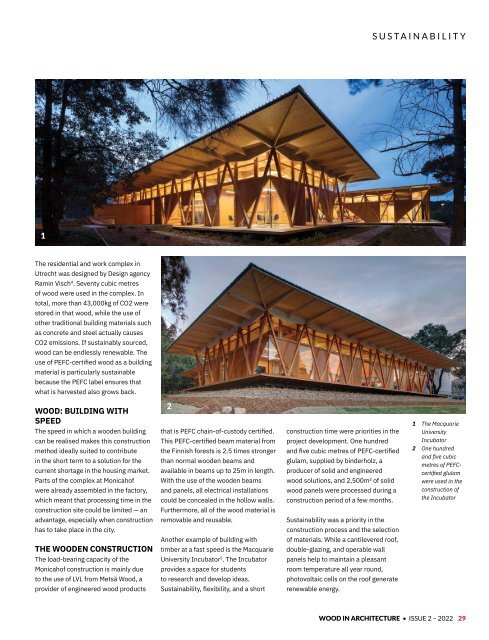Wood In Architecture Issue 2, 2022
First published in 2017, Wood in Architecture (WIA) is a bi-annual trade magazine devoted to the international timber construction sector. The newest addition to the Panels & Furniture Group of wood magazines, WIA features in-depth insights to the latest industry news, incredible projects and leading trade events. WIA is an advocate for timber as a material of choice for today’s built environment, and is the perfect source of inspiration for architects, builders, engineers and interior designers across the globe.
First published in 2017, Wood in Architecture (WIA) is a bi-annual trade magazine devoted to the international timber construction sector. The newest addition to the Panels & Furniture Group of wood magazines, WIA features in-depth insights to the latest industry news, incredible projects and leading trade events. WIA is an advocate for timber as a material of choice for today’s built environment, and is the perfect source of inspiration for architects, builders, engineers and interior designers across the globe.
Create successful ePaper yourself
Turn your PDF publications into a flip-book with our unique Google optimized e-Paper software.
SUSTAINABILITY<br />
1<br />
The residential and work complex in<br />
Utrecht was designed by Design agency<br />
Ramin Visch 4 . Seventy cubic metres<br />
of wood were used in the complex. <strong>In</strong><br />
total, more than 43,000kg of CO2 were<br />
stored in that wood, while the use of<br />
other traditional building materials such<br />
as concrete and steel actually causes<br />
CO2 emissions. If sustainably sourced,<br />
wood can be endlessly renewable. The<br />
use of PEFC-certified wood as a building<br />
material is particularly sustainable<br />
because the PEFC label ensures that<br />
what is harvested also grows back.<br />
WOOD: BUILDING WITH<br />
SPEED<br />
The speed in which a wooden building<br />
can be realised makes this construction<br />
method ideally suited to contribute<br />
in the short term to a solution for the<br />
current shortage in the housing market.<br />
Parts of the complex at Monicahof<br />
were already assembled in the factory,<br />
which meant that processing time in the<br />
construction site could be limited — an<br />
advantage, especially when construction<br />
has to take place in the city.<br />
THE WOODEN CONSTRUCTION<br />
The load-bearing capacity of the<br />
Monicahof construction is mainly due<br />
to the use of LVL from Metsä <strong>Wood</strong>, a<br />
provider of engineered wood products<br />
2<br />
that is PEFC chain-of-custody certified.<br />
This PEFC-certified beam material from<br />
the Finnish forests is 2.5 times stronger<br />
than normal wooden beams and<br />
available in beams up to 25m in length.<br />
With the use of the wooden beams<br />
and panels, all electrical installations<br />
could be concealed in the hollow walls.<br />
Furthermore, all of the wood material is<br />
removable and reusable.<br />
Another example of building with<br />
timber at a fast speed is the Macquarie<br />
University <strong>In</strong>cubator 5 . The <strong>In</strong>cubator<br />
provides a space for students<br />
to research and develop ideas.<br />
Sustainability, flexibility, and a short<br />
construction time were priorities in the<br />
project development. One hundred<br />
and five cubic metres of PEFC-certified<br />
glulam, supplied by binderholz, a<br />
producer of solid and engineered<br />
wood solutions, and 2,500m² of solid<br />
wood panels were processed during a<br />
construction period of a few months.<br />
Sustainability was a priority in the<br />
construction process and the selection<br />
of materials. While a cantilevered roof,<br />
double-glazing, and operable wall<br />
panels help to maintain a pleasant<br />
room temperature all year round,<br />
photovoltaic cells on the roof generate<br />
renewable energy.<br />
1 The Macquarie<br />
University<br />
<strong>In</strong>cubator<br />
2 One hundred<br />
and five cubic<br />
metres of PEFCcertified<br />
glulam<br />
were used in the<br />
construction of<br />
the <strong>In</strong>cubator<br />
WOOD IN ARCHITECTURE • ISSUE 2 – <strong>2022</strong> 29


















